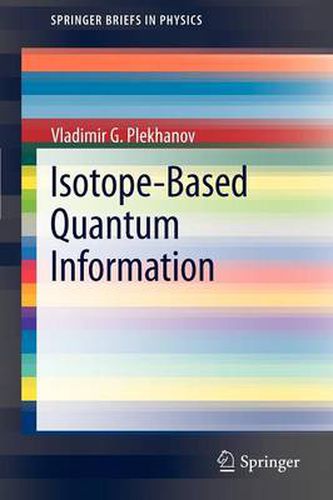Readings Newsletter
Become a Readings Member to make your shopping experience even easier.
Sign in or sign up for free!
You’re not far away from qualifying for FREE standard shipping within Australia
You’ve qualified for FREE standard shipping within Australia
The cart is loading…






This title is printed to order. This book may have been self-published. If so, we cannot guarantee the quality of the content. In the main most books will have gone through the editing process however some may not. We therefore suggest that you be aware of this before ordering this book. If in doubt check either the author or publisher’s details as we are unable to accept any returns unless they are faulty. Please contact us if you have any questions.
The present book provides to the main ideas and techniques of the rapid progressing field of quantum information and quantum computation using isotope - mixed materials. It starts with an introduction to the isotope physics and then describes of the isotope - based quantum information and quantum computation. The ability to manipulate and control electron and/or nucleus spin in semiconductor devices provides a new route to expand the capabilities of inorganic semiconductor-based electronics and to design innovative devices with potential application in quantum computing. One of the major challenges towards these objectives is to develop semiconductor-based systems and architectures in which the spatial distribution of spins and their properties can be controlled. For instance, to eliminate electron spin decoherence resulting from hyperfine interaction due to nuclear spin background, isotopically controlled devices are needed (i.e., nuclear spin-depleted). In other emerging concepts, the control of the spatial distribution of isotopes with nuclear spins is a prerequisite to implement the quantum bits (or qbits). Therefore, stable semiconductor isotopes are important elements in the development of solid-state quantum information. There are not only different algorithms of quantum computation discussed but also the different models of quantum computers are presented. With numerous illustrations this small book is of great interest for undergraduate students taking courses in mesoscopic physics or nanoelectronics as well as quantum information, and academic and industrial researches working in this field.
$9.00 standard shipping within Australia
FREE standard shipping within Australia for orders over $100.00
Express & International shipping calculated at checkout
This title is printed to order. This book may have been self-published. If so, we cannot guarantee the quality of the content. In the main most books will have gone through the editing process however some may not. We therefore suggest that you be aware of this before ordering this book. If in doubt check either the author or publisher’s details as we are unable to accept any returns unless they are faulty. Please contact us if you have any questions.
The present book provides to the main ideas and techniques of the rapid progressing field of quantum information and quantum computation using isotope - mixed materials. It starts with an introduction to the isotope physics and then describes of the isotope - based quantum information and quantum computation. The ability to manipulate and control electron and/or nucleus spin in semiconductor devices provides a new route to expand the capabilities of inorganic semiconductor-based electronics and to design innovative devices with potential application in quantum computing. One of the major challenges towards these objectives is to develop semiconductor-based systems and architectures in which the spatial distribution of spins and their properties can be controlled. For instance, to eliminate electron spin decoherence resulting from hyperfine interaction due to nuclear spin background, isotopically controlled devices are needed (i.e., nuclear spin-depleted). In other emerging concepts, the control of the spatial distribution of isotopes with nuclear spins is a prerequisite to implement the quantum bits (or qbits). Therefore, stable semiconductor isotopes are important elements in the development of solid-state quantum information. There are not only different algorithms of quantum computation discussed but also the different models of quantum computers are presented. With numerous illustrations this small book is of great interest for undergraduate students taking courses in mesoscopic physics or nanoelectronics as well as quantum information, and academic and industrial researches working in this field.